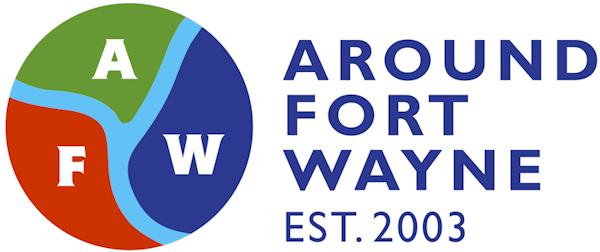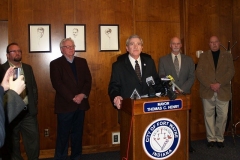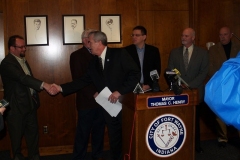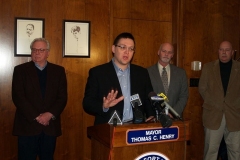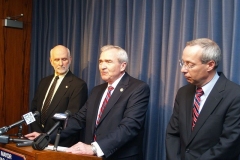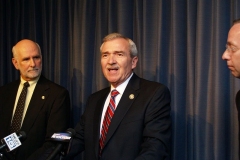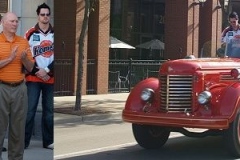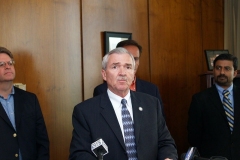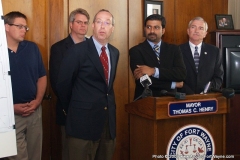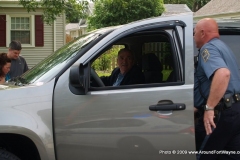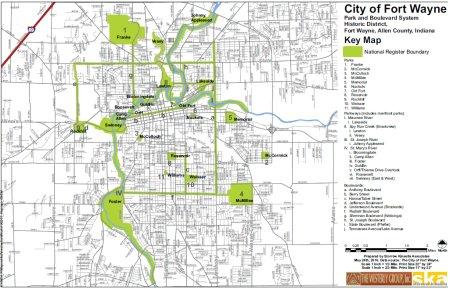
Press release from the City of Fort Wayne:
Fort Wayne’s Park and Boulevard System now on National Historic Register
Historic district designation rare for Indiana parks system
(January 7, 2011) – Fort Wayne Mayor Tom Henry and Fort Wayne Park Board President Rick Samek announced today that the city’s Park and Boulevard System Historic District is now listed on the National Register of Historic Places by the United States Department of the Interior. It is the second such designation for a park system in Indiana and joins a small number of systems listed nationwide.
The National Register of Historic Places recognizes the Fort Wayne Park and Boulevard System Historic District as an example of a comprehensive public space and transportation system developed from 1909 to 1955.
“The legacy of this park master plan lives on today at some of Fort Wayne’s most cherished parks including Lakeside, Foster, Swinney, McMillen and Franke and more. We should all be grateful for the foresight from our city’s leaders a century ago, and now that heritage is recognized nationally,” Mayor Henry said.
The City’s park and boulevard system grew out of the City Beautiful movement, which was sparked by the 1893 Chicago World’s Fair. City Beautiful was premised on the principals now commonly used in city and urban planning and coincided with much of Fort Wayne’s park and city growth in the first half of the 20th century.
“We are now entrusted with what has become some of the community’s finest public spaces that have delighted people of all ages for decades. This listing on the National Register of Historic Places allows for the Parks and Recreation Department and entire city to continue that tradition,” said Parks Board President Samek.
Fort Wayne’s first park and boulevard master plan was presented to the community in 1909 by Charles Mulford Robinson, a pioneer of urban planning in the United States. Development of the plan continued with pioneer landscape architect and planner George Kessler in 1911 and 1912. In 1927 the firm of Bennett, Parsons & Frost updated the plan again in with the influence of local planners. By 1955 most of the plan had been implemented and the key elements were in place. The plan also provided a geographic backbone to the Rivergreenway trail system along Fort Wayne’s riverbanks.
A listing on the National Register of Historic Places provides recognition of the history and design significance of the Fort Wayne Park and Boulevard system as it reaches its centennial. Local appreciation of historic park resources has been growing steadily for many years, and the nomination provides the documentation needed for broad public education and interpretation initiatives.
The designation enhances funding opportunities to maintain the community’s historic resources and will serve as a consideration for planning park and transportation projects.
The Fort Wayne Department of Parks and Recreation partnered with the Fort Wayne Division of Community Development in listing the historic components of the park and boulevard system in the National Register. Friends of the Parks of Allen County and ARCH, Inc. were also instrumental in the initiation and support of this project.
The City of Fort Wayne obtained federal grants administered through Indiana’s Division of Historic Preservation and Archaeology to help fund the application preparation to the National Register of Historic Places. The City contracted with the Westerly Group and Storrow-Kinsella Associates to research the district and prepare the nomination. The completed application was reviewed by the Fort Wayne Historic Preservation Commission before it was forwarded to the Indiana Historic Preservation Review Board and finally to the National Park Service.
The 1912 George Kessler Plan for Fort Wayne provided for efficient circulation of traffic on grand boulevards around what was then the perimeter of the city. It also provided locations for scenic parks and parkways along the City’s rivers and streams. The plan also identified development sites that became many of Fort Wayne’s most popular neighborhoods of the last century. Many of these residential areas have been listed on the National Register as historic districts or are considered to be eligible for listing.
The Fort Wayne Park and Boulevard System Historic District is nationally significant for its association with a master planner and a landscape architect who were both key figures in the early city planning movement: Charles Mulford Robinson and George Kessler. Arthur Shurcliff, one of the great master landscape architects of the 20th century, also designed components to the plan throughout his career.
The Fort Wayne Park and Boulevard System Historic District includes the historic parks, parkways, and boulevards located within the city limits as shown on the 1912 Kessler plan; also included are historic parks, parkways, and greenways which were logical extensions of the Kessler plan through 1955. The historic district is roughly inclusive of the following parks and adjacent rights-of-way: Franke, McCormick, McCulloch, McMillen, Memorial, Nuckols, Old Fort, Reservoir, Rockhill, Weisser, and Williams. The historic district also includes the following water (river) based parks, parkways, and associated green space: Maumee River from the three rivers confluence to White Oak Dr, including Lakeside Park; Spy Run Creek from St. Mary’s River to Norfolk Avenue, including Lawton Park and Vesey Park; St. Joseph River from three rivers confluence to Coliseum Boulevard, including Johnny Appleseed Park; St. Mary’s River from three rivers confluence to Fairfield Avenue, including Bloomingdale Park, Foster Park, Guldlin Park, Orff Park, the Thieme Dr. Overlook, Roosevelt Park, Camp Allen, and Swinney Park (East & West).
The historic district also includes the rights-of-way of the following boulevards: Anthony Boulevard from Crescent to Rudisill, Berry Street from Hanna to Thieme, Hanna Street from Rudisill to Taber, Taber Street from Hanna to Lafayette, Jefferson Boulevard from Thieme to Lindenwood, Lindenwood Avenue from Jefferson to W. State, Rudisill Boulevard from McMillen Park to Foster Park, Sherman Boulevard from St. Mary’s River to Franke Park, St. Joseph Boulevard from Columbia to E. State, State Boulevard from Anthony to Lindenwood, Tennessee Avenue from Spy Run Avenue to California, and Lake Avenue from Forest Park to Anthony.
The National Register of Historic Places is the Federal government’s official list of prehistoric and historic properties worthy of preservation. In Indiana, this program is administered by the Department of Natural Resources-Division of Historic Preservation and Archaeology, with assistance from the City of Fort Wayne as a Certified Local Government. Listing in the National Register provides recognition and assists in preserving our nation’s heritage. It does not prevent private owners from altering, demolishing, or disposing of the property as they choose.
Download a map of the Park and Boulevard System
Also, you might wish to check out a lecture on Rudisill Bouleavard by Jim Sack. Â Rudisill Boulevard is one of the legs of the system.
